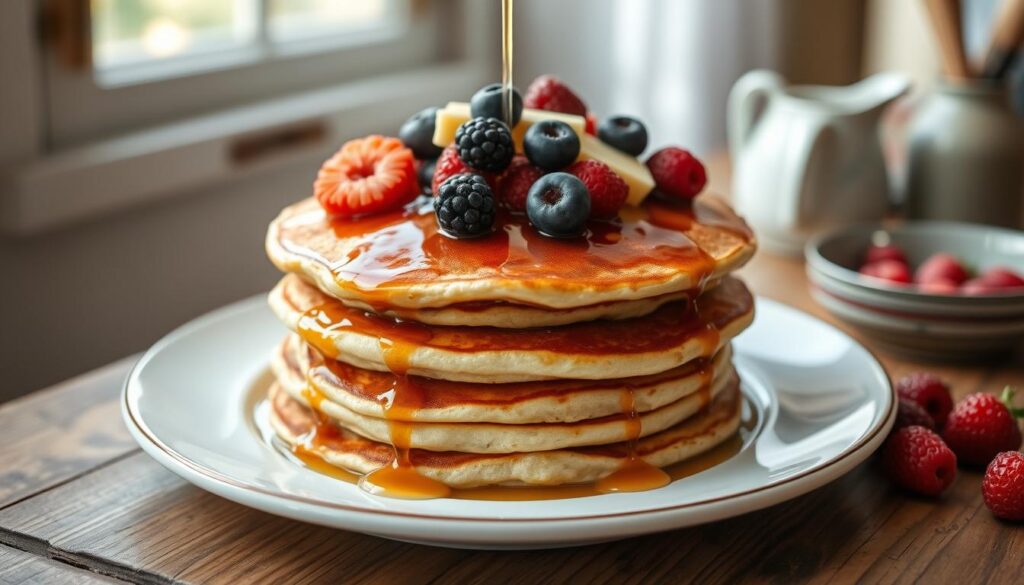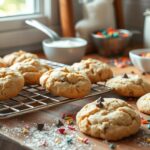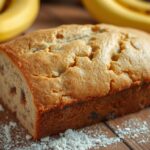Indulge in fluffy, homemade pancakes with this delicious recipe. Learn how to make the perfect pancake at home.
Table of Contents
They love making homemade pancakes for breakfast, and it’s easy to see why – a delicious pancake recipe can be a great way to start the day. With a long history that spans across many cultures, pancakes have become a staple in many breakfast recipes. From classic buttermilk pancakes to creative variations, making pancakes from scratch allows for a level of customization and quality that can’t be beat.
A key part of what makes a great pancake recipe is using quality ingredients, and having the right kitchen tools and equipment. By following a simple pancake recipe and using the right techniques, anyone can make delicious homemade pancakes that rival those found in restaurants. In this article, they will cover the essential ingredients, kitchen tools, and cooking techniques needed to make perfect pancakes, including a classic buttermilk pancake recipe and tips for mastering the cooking process.
Making homemade pancakes is a great way to enjoy a tasty breakfast, and with a little practice, anyone can become a pro at making delicious breakfast recipes. By following a simple pancake recipe and using quality ingredients, they can create a delicious and memorable meal that is sure to please. Whether you’re a seasoned chef or a beginner in the kitchen, making homemade pancakes is a great way to start the day, and with the right techniques and ingredients, you can create a delicious pancake recipe that will become a staple in your household.
The History of Pancakes: From Ancient Grains to Modern Breakfast
Pancakes have a rich pancake history, dating back to ancient times when people first began grinding grains into flour. The earliest pancakes were made from wheat, oats, or barley, and were often cooked on hot stones or griddles.
As cultural influences spread, different regions developed their own unique pancake recipes and breakfast traditions. In France, thin pancakes called crepes became a staple, while in the United States, fluffy buttermilk pancakes were a favorite.
Origins of Pancakes Across Cultures
- France: crepes
- United States: buttermilk pancakes
- India: dosas
Evolution of American Pancakes
American pancakes have evolved over time, with the introduction of new ingredients and cooking techniques. Today, pancakes are a popular breakfast tradition in many parts of the world.
| Country | Pancake Type |
|---|---|
| France | Crepes |
| United States | Buttermilk Pancakes |
| India | Dosas |
Essential Ingredients for the Perfect Pancake Recipe
To make perfect pancakes, it’s crucial to use the right pancake ingredients. Quality ingredients such as fresh eggs, real butter, and pure vanilla extract can make a significant difference in the taste and texture of your pancakes. When it comes to cooking essentials, having the right type of flour is vital. You can choose from all-purpose flour, whole wheat flour, or oat flour, depending on your preference.
Here are some key recipe requirements to keep in mind:
- Use fresh and high-quality ingredients
- Measure ingredients accurately
- Mix wet and dry ingredients separately
A good pancake recipe should include a balance of dry and wet ingredients. The dry ingredients typically include flour, sugar, and baking powder, while the wet ingredients include milk, eggs, and butter. By using the right pancake ingredients and following a reliable recipe, you can create delicious and fluffy pancakes that are sure to please.
Some popular brands that offer high-quality cooking essentials include King Arthur Flour and Land O’Lakes. When shopping for ingredients, be sure to read labels carefully and choose products that meet your recipe requirements. With the right ingredients and a little practice, you can become a pancake-making pro and enjoy a delicious breakfast or brunch with family and friends.
Kitchen Tools and Equipment Needed
To make delicious pancakes, you’ll need the right kitchen tools and cooking equipment. A whisk, measuring cups, and a frying pan are essential utensils. Optional equipment like a griddle or blender can also be useful for achieving better results.
When it comes to cooking pancakes, the choice between a griddle vs pan is important. A griddle provides a large, flat surface for cooking multiple pancakes at once, while a pan is better suited for cooking a few pancakes at a time. The type of cooking equipment you use can affect the texture and flavor of your pancakes.
Basic Utensils Required
- Whisk
- Measuring cups
- Frying pan
Optional Equipment for Better Results
- Griddle
- Blender
Griddle vs. Pan Comparison
| Equipment | Advantages | Disadvantages |
|---|---|---|
| Griddle | Cooks multiple pancakes at once, easy to flip | Takes up more space, can be heavy |
| Pan | Easy to store, lightweight | Cooks fewer pancakes at a time, can be tricky to flip |
By choosing the right kitchen tools and cooking equipment, you can make delicious pancakes that are sure to please. Whether you prefer a griddle or pan, the key is to find the equipment that works best for you and your cooking style.
Classic Buttermilk Pancake Recipe
When it comes to breakfast ideas, few dishes are as beloved as buttermilk pancakes. This classic recipe has been a staple of American cuisine for generations, and its enduring popularity is a testament to the power of simple, high-quality ingredients. Buttermilk pancakes are a versatile dish that can be enjoyed at any time of day, whether you’re looking for a hearty breakfast, a satisfying brunch, or a delicious dessert.
To make the perfect buttermilk pancakes, you’ll need a few key ingredients, including fresh buttermilk, all-purpose flour, and a touch of sugar. You can also add in your favorite mix-ins, such as blueberries, bananas, or nuts, to give your pancakes an extra burst of flavor. Here are some tips for making the perfect buttermilk pancakes:
- Use high-quality ingredients, including fresh buttermilk and real butter
- Don’t overmix the batter, as this can lead to tough, dense pancakes
- Use the right amount of sugar, as this will help to balance out the tanginess of the buttermilk
With these tips and a little practice, you’ll be well on your way to making delicious buttermilk pancakes that are sure to please even the pickiest eaters. Whether you’re looking for a classic recipe to serve at a family breakfast or a creative twist on a beloved dish, buttermilk pancakes are a great choice. So why not give them a try and see what all the fuss is about? You can also experiment with different breakfast ideas and toppings to make your buttermilk pancakes truly special.
Step-by-Step Mixing Technique
To achieve the perfect pancake, it’s essential to master the mixing technique. This involves combining dry ingredients, such as flour, sugar, and baking powder, with wet ingredients, like eggs, milk, and butter. The key is to blend these components without overmixing, which can result in tough pancakes.
The mixing technique requires patience and attention to detail. Start by preparing the dry ingredients, whisking them together in a large bowl. Next, integrate the wet ingredients, stirring gently to avoid creating a tough batter. The goal is to achieve a smooth, even batter consistency that’s not too thick or too thin.
Dry Ingredient Preparation
When preparing the dry ingredients, it’s crucial to sift the flour and other powders to remove any lumps. This ensures an even texture and helps the pancakes cook evenly. The right cooking methods also play a significant role in the final result, as they can affect the texture and flavor of the pancakes.
Wet Ingredient Integration
When integrating the wet ingredients, it’s essential to stir gently, avoiding overmixing. This can be achieved by using a gentle folding motion, combining the wet and dry ingredients until just combined. The resulting batter consistency should be smooth and even, with no lumps or streaks.
Achieving the Perfect Batter Consistency
To achieve the perfect batter consistency, it’s crucial to balance the liquid and dry ingredients. If the batter is too thick, add a little more milk or water. If it’s too thin, add a little more flour. The right mixing technique and cooking methods will result in pancakes that are light, fluffy, and full of flavor.
Mastering the Cooking Process
To achieve perfect pancake cooking, it’s essential to master the cooking techniques, including heat control. The right heat can make a significant difference in the texture and color of the pancakes. Heat control is crucial, as it can affect the cooking time and the final result. When cooking pancakes, it’s vital to adjust the cooking time to achieve the desired level of doneness.
Cooking techniques, such as using a griddle or a pan, can also impact the final result. For example, a griddle can provide a more even heat distribution, while a pan can offer more control over the cooking process. When cooking pancakes in bulk, it’s essential to consider the cooking method and adjust the cooking time accordingly.
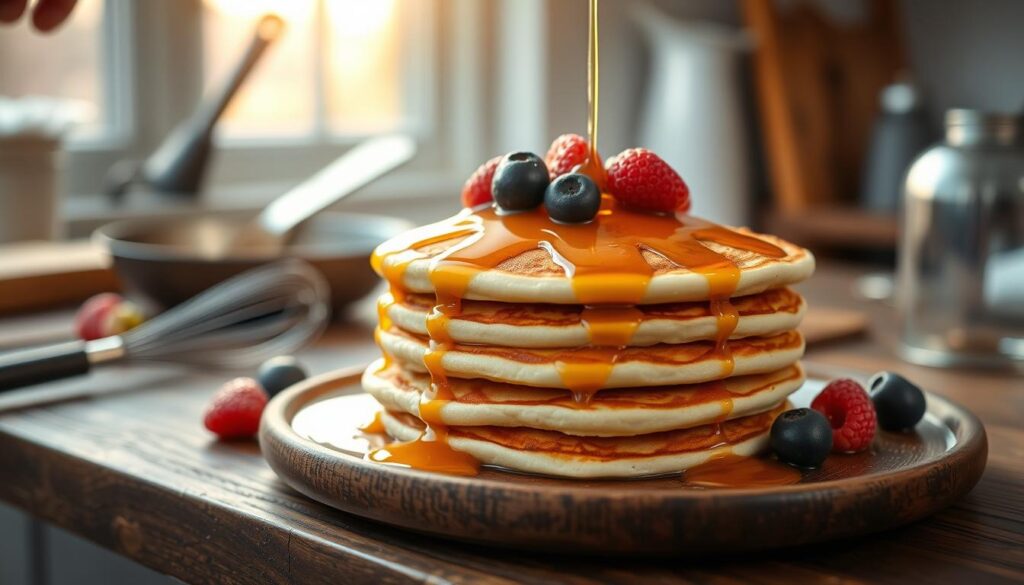
- Using the right heat control to achieve the perfect texture and color
- Adjusting the cooking time to achieve the desired level of doneness
- Considering the cooking method, such as using a griddle or a pan, to impact the final result
By mastering the cooking techniques and heat control, you can achieve perfect pancake cooking and enjoy a delicious breakfast. With practice and patience, you can develop the skills needed to cook pancakes like a pro and impress your family and friends with your culinary skills.
| Cooking Method | Heat Control | Cooking Time |
|---|---|---|
| Griddle | Medium heat | 2-3 minutes per side |
| Pan | Medium-low heat | 2-3 minutes per side |
Common Pancake Making Mistakes to Avoid
When making pancakes, it’s easy to encounter common mistakes that can affect the texture and taste of the final product. Pancake problems such as overmixing the batter, using the wrong type of flour, or cooking at the wrong temperature can lead to dense, tough, or burnt pancakes.
To avoid these common mistakes, it’s essential to understand the importance of using the right ingredients, cooking techniques, and equipment. By following simple cooking solutions such as adjusting the batter consistency, using the right heat, and flipping the pancakes at the right time, you can achieve fluffy, golden-brown pancakes.
Batter Problems and Solutions
- Overmixing the batter: Stop mixing as soon as the ingredients are combined.
- Incorrect flour ratio: Use the right type and amount of flour for the recipe.
- Insufficient leavening: Add the right amount of baking powder or baking soda.
Temperature Control Issues
Temperature control is crucial when making pancakes. If the heat is too high, the pancakes will burn; if it’s too low, they won’t cook properly. To avoid temperature control issues, use a thermometer to ensure the right temperature and adjust the heat as needed.
| Temperature | Effect on Pancakes |
|---|---|
| Too high | Burnt pancakes |
| Too low | Undercooked pancakes |
| Just right | Fluffy, golden-brown pancakes |
Creative Pancake Variations and Toppings
When it comes to pancake variations, the possibilities are endless. Experimenting with different ingredients and flavors can help create unique and delicious pancakes. For breakfast ideas, consider adding fresh fruits, nuts, or chocolate chips to your pancake batter. These creative toppings can add natural sweetness and texture to your pancakes.
Some popular pancake variations include sweet options like blueberry or banana pancakes, while savory alternatives like cheese and bacon or spinach and feta can add a nice twist to your breakfast routine. To take your pancakes to the next level, try using different types of flour, such as whole wheat or oat flour, and add some spices like cinnamon or nutmeg.
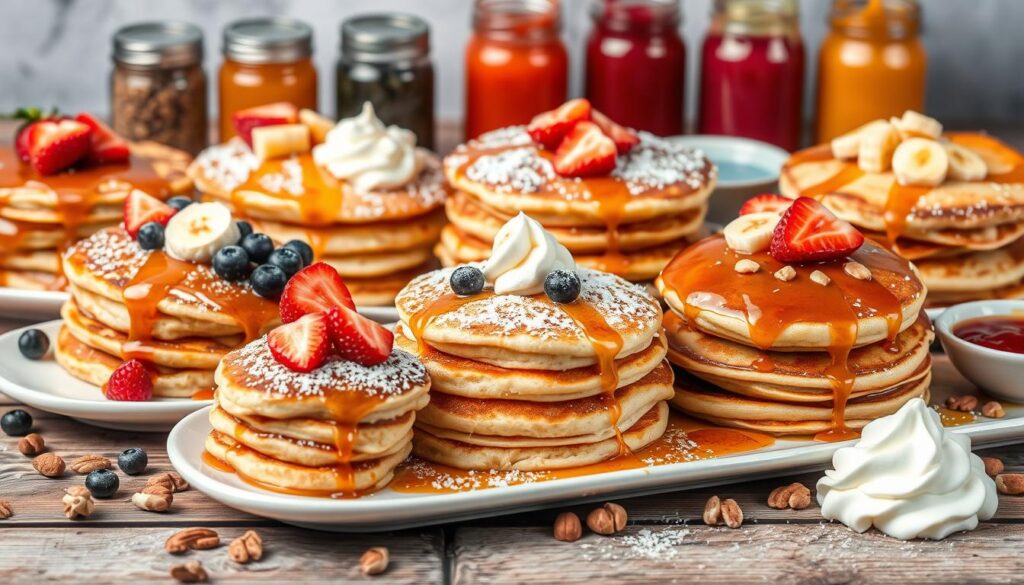
- Fresh fruits like strawberries, blueberries, or bananas
- Nuts like walnuts, almonds, or pecans
- Chocolate chips or shavings
- Caramel sauce or honey
- Whipped cream or yogurt
By experimenting with different pancake variations and creative toppings, you can create a variety of breakfast ideas that are both delicious and visually appealing. Whether you’re in the mood for something sweet or savory, there’s a pancake variation out there for you.
| Pancake Variation | Ingredients | Toppings |
|---|---|---|
| Blueberry Pancakes | Blueberries, flour, sugar, eggs | Whipped cream, fresh blueberries |
| Banana Pancakes | Bananas, flour, sugar, eggs | Maple syrup, chopped nuts |
| Cheese and Bacon Pancakes | Flour, eggs, cheese, bacon | Sour cream, chives |
Storage and Reheating Guidelines
When it comes to storing and reheating pancakes, it’s essential to follow proper food safety guidelines to ensure they remain fresh and safe to eat. One of the most important storage tips is to keep pancakes in airtight containers, either at room temperature or in the refrigerator. This will help prevent moisture from accumulating and reducing the risk of bacterial growth.
For longer-term storage, consider freezing your pancakes. This method is ideal for preserving the texture and flavor of the pancakes. When freezing, make sure to wrap the pancakes tightly in plastic wrap or aluminum foil and place them in a freezer-safe bag. To reheat frozen pancakes, simply thaw them overnight in the refrigerator and then reheat them using your preferred reheating methods, such as microwaving or toasting.
Some useful storage tips and reheating methods include:
- Storing pancakes in a single layer to prevent them from sticking together
- Using a toaster or toaster oven to reheat pancakes, as this method helps retain their crispy texture
- Reheating pancakes in the microwave, covered with a damp paper towel to maintain moisture
By following these storage tips and reheating methods, you can enjoy your pancakes for a longer period while maintaining their quality and ensuring food safety.
Expert Tips for Restaurant-Quality Pancakes
To achieve restaurant-quality pancakes, it’s essential to follow expert tips and professional techniques. Using high-quality ingredients, such as fresh eggs and real butter, can make a significant difference in the texture and flavor of your pancakes.
One of the key expert tips is to use a griddle or a commercial mixer to make pancakes. This helps to achieve the perfect texture and consistency. Additionally, using a thermometer to ensure the right temperature can help to cook the pancakes evenly.
Professional Techniques
Some professional techniques to try include folding in ingredients gently, not overmixing the batter, and using the right type of flour. These techniques can help to create a light and fluffy pancake that is similar to those found in restaurants.
Secret Ingredients
Some secret ingredients that can be used to make restaurant-quality pancakes include vanilla extract, cinnamon, and a pinch of salt. These ingredients can add depth and complexity to the flavor of the pancakes, making them more interesting and delicious.
By following these expert tips and professional techniques, you can create restaurant-quality pancakes in the comfort of your own home. Remember to always use high-quality ingredients and to pay attention to the details, such as temperature and texture, to achieve the best results.
- Use a cast-iron skillet or griddle to cook the pancakes, as these retain heat well and can help to create a crispy exterior.
- Don’t overflip the pancakes, as this can make them tough and dense.
- Experiment with different types of flour, such as whole wheat or oat flour, to create a unique flavor and texture.
| Ingredient | Quantity | Purpose |
|---|---|---|
| Fresh eggs | 2 | Moisture and richness |
| Real butter | 1/4 cup | Flavor and texture |
| Vanilla extract | 1 tsp | Flavor and aroma |
Conclusion: Perfecting Your Pancake Game
As you’ve discovered, mastering the art of making delicious homemade pancakes is an ongoing journey of experimentation and practice. By following the essential techniques and tips outlined in this guide, you’re well on your way to perfecting your pancake game.
Remember, the key to consistently flawless pancakes lies in paying close attention to ingredient ratios, temperature control, and proper mixing methods. With each batch, you’ll gain valuable experience and develop your own unique pancake-making style.
Don’t be afraid to experiment with creative flavor combinations and toppings to satisfy your personal preferences. Pancakes are a versatile canvas for culinary expression. Keep refining your skills, and soon you’ll be impressing family and friends with restaurant-quality pancakes in the comfort of your own kitchen.
So, what are you waiting for? Grab your mixing bowl, fire up the griddle, and let the pancake-making begin! Share your favorite recipes and pancake-making tips in the comments below. Happy flipping!

